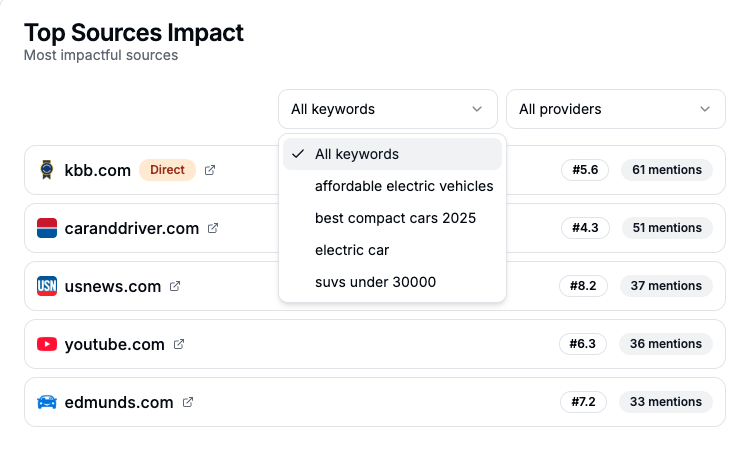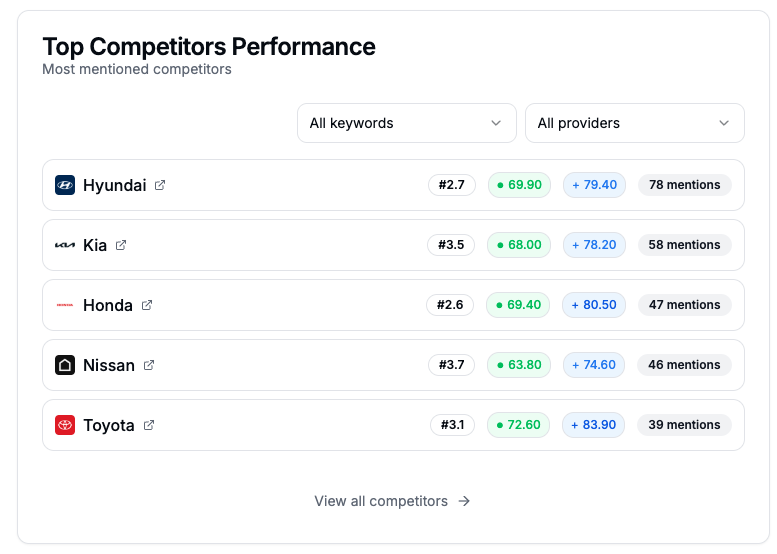The Performance Dashboard is Qwairy’s central hub for tracking how well your brand shows up in AI-generated answers from models like ChatGPT, Perplexity, Gemini, Claude, and more.
It doesn’t just tell you if your brand is mentioned — it tells you where, how often, in what tone, and with what level of authority.
On this documentation page we will detail how you can use this performance dashboard to take strategic decisions.
1. 🔍 Overview of Key Metrics
At the top of the dashboard, you’ll find 5 core performance indicators:
| Metric | What it tells you |
|---|
| Brand Mention Visibility | How often your brand appears in AI-generated answers |
| Source Citation Visibility | Whether AI models are referencing your actual content |
| Average Position | Where your brand ranks among others when listed in responses |
| Average Sentiment | The tone (positive/neutral/negative) associated with your brand |
| Share of Voice | Your brand’s percentage of total mentions vs. all competitors |
| Relevance | How well the answers match the intent of the query |
💡 Pro Tip: A high mention rate without source citations can be risky. It means you’re talked about, but others control the narrative. Focus on both visibility and authority.
2. 📈 Deep Dive into Metrics
🟠 Brand Mention Visibility
- The percentage of queries where your brand is explicitly mentioned in the AI’s answer you have added on Qwairy.
- Example: 27% means your brand shows up in just over a quarter of analyzed queries.
Please note that we only take into account the queries where one competitor is
mentioned to define Brand Mention Visibility.
- Identify where you’re absent and why
- Benchmark yourself against top competitors in your space
📎 Source Citation Visibility
- Measures how often your own site or content is cited as a source.
- Example: 0% means you’re never referenced — even if you’re mentioned.
⚠️ AI may talk about your brand but rely on external sources, including your competitors.
💡 Pro Tip: Improve this by updating your website content, publishing on trusted platforms (Wikipedia, Crunchbase, news sites), and ensuring pages have structured, factual information.
🏅 Average Position
- Your average rank when multiple brands are mentioned in the same answer.
- If you’re frequently mentioned but rank behind others (e.g., Toyota, Ford), your visibility is present but not dominant.
This score is especially useful when competing in crowded markets.
😀 Average Sentiment
- Indicates how positively (or negatively) your brand is portrayed in AI responses.
- Score from 0 to 100 — the higher, the better.
- Useful for reputation tracking, product perception, and brand positioning.
📢 Share of Voice
- Measures your brand’s percentage of total mentions compared to all competitors in AI responses.
- Example: If you have 25% Share of Voice, your brand represents a quarter of all brand mentions in your competitive landscape.
- Calculated as:
(Your brand mentions ÷ Total competitor mentions) × 100
🎯 Use this to:
- Benchmark market dominance: Higher Share of Voice indicates stronger AI visibility leadership
- Track competitive positioning: Monitor if competitors are gaining ground in AI conversations
- Identify growth opportunities: Low Share of Voice reveals potential for increased AI presence
💡 Pro Tip: A declining Share of Voice might indicate competitors are creating more AI-friendly content or getting better source citations. Use this metric to prioritize your content strategy.
🎯 Relevance
- Tells you how closely the answer matches the intent of the query.
- High relevance = your brand is appearing in meaningful, on-topic contexts.
💡 A brand might appear often but in irrelevant places — which can dilute its value.
Qwairy breaks down your visibility by LLM model (e.g., GPT-4o, Sonar, AI Overview):
| Provider | Brand Mentions | Source Citations | Sentiment | Relevance |
|---|
| AI Overview | 32% | 0% | 71.4 | 100 |
| Sonar | 29% | 0% | 64.4 | 91 |
| GPT‑4o Mini | 24% | 0% | 71.3 | 100 |
 💡 Pro Tips: Depending on where you’re lacking visibility you can define your backlink strategy. If you are absent from GPT-4o you might want to make sure you are present on GPT’s sources.
💡 Pro Tips: Depending on where you’re lacking visibility you can define your backlink strategy. If you are absent from GPT-4o you might want to make sure you are present on GPT’s sources.
 Explore how you perform on each strategic topic (e.g., “electric cars” or “SUVs under $30k”):
Explore how you perform on each strategic topic (e.g., “electric cars” or “SUVs under $30k”):
- Presence rate
- Ranking position
- Source citation rate
- Sentiment and relevance scores
Example:
You’re mentioned in 33% of queries about “electric cars” — but cited 0%.
That means you’re visible but not trusted as a source. Content opportunity spotted.
6. Top Sources Impact
The Top Sources Impact section in Qwairy shows which external websites have the greatest influence on how your brand is represented in AI-generated answers.
LLMs (Large Language Models) don’t just pull information from your website — they draw from trusted external sources. This view helps you answer two essential questions:
- 💡 “Which domains are shaping how my brand is portrayed?”
- 💡 “Am I present in the sources AI models trust the most?”
 💡 Tip: If a site like
💡 Tip: If a site like kbb.com is often cited and your brand isn’t mentioned there → get listed, publish content, or update outdated info on that platform.
Granular Insights by Keyword & Provider
Qwairy gives you the power to filter source impact data:
✅ By Keyword (Topic-specific view)
You can analyze source impact for each keyword or theme, such as:
electric caraffordable electric vehiclessuvs under 30000best compact cars 2025
👉 This allows you to understand which sources dominate a specific conversation.
Example:
youtube.com may dominate on “SUV reviews”usnews.com might be stronger on “affordable EVs”
This helps you prioritize where to be visible based on your positioning goals.
✅ By Provider (AI model-specific view)
Since LLMs don’t use the same sources, you can also filter by:
- GPT-4
- Claude
- Gemini
- Sonar
- AI Overview
👉 This helps you tailor your efforts to the AI model most used by your audience.
The Top Competitors Performance module in Qwairy shows you which brands are most frequently mentioned in AI-generated answers — and how they’re performing relative to yours.
This section is essential to understanding:
- Who dominates your category in AI search
- How each competitor is perceived
- Where you might be underrepresented

🔁 Filter by Keyword or Provider
You can go very granular by slicing this data:
✅ By Keyword
See which competitors dominate specific themes or verticals, such as:
- “Electric cars”
- “Affordable SUVs”
- “Best compact cars 2025”
→ This reveals who is winning per topic, so you can identify gaps and focus your content efforts strategically.
✅ By Provider
Filter by AI model (GPT-4o, Sonar, Claude, etc.) to:
- See which competitors are favored by each LLM
- Understand if some models are skewed toward certain brands
- Adjust your content strategy accordingly





